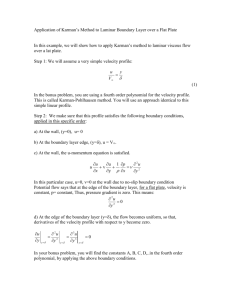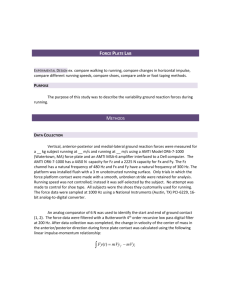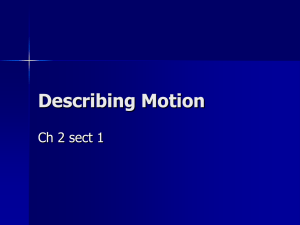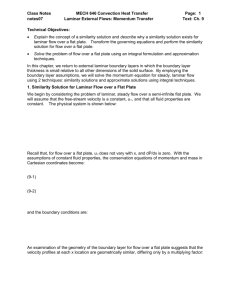BOUNDARY LAYERS
advertisement
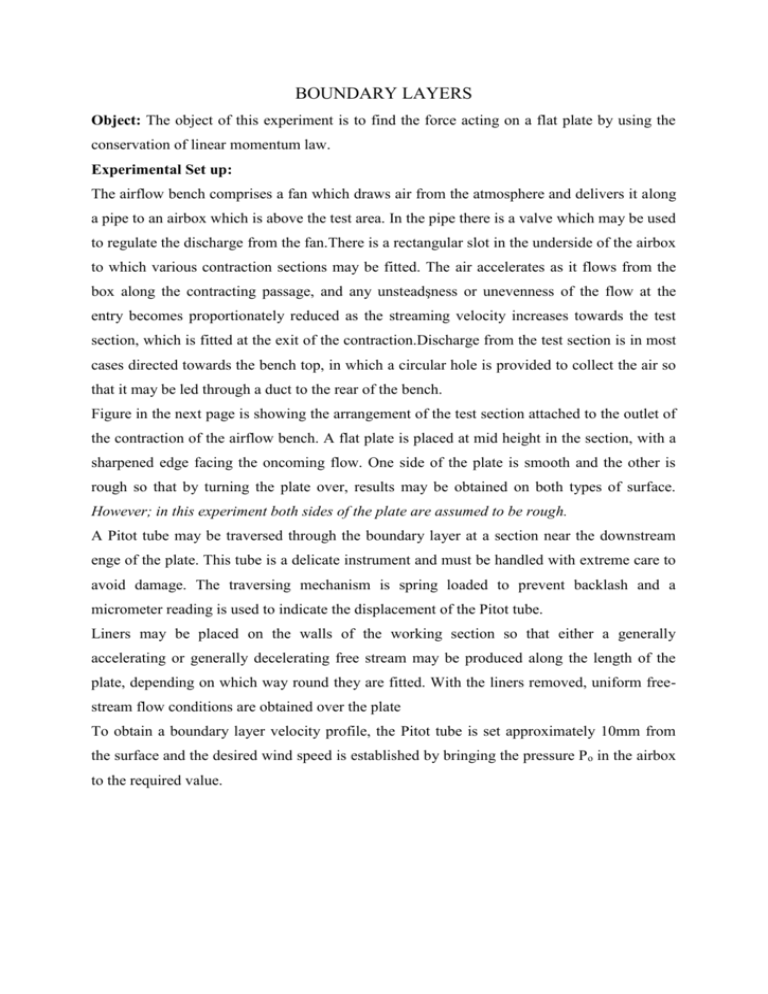
BOUNDARY LAYERS Object: The object of this experiment is to find the force acting on a flat plate by using the conservation of linear momentum law. Experimental Set up: The airflow bench comprises a fan which draws air from the atmosphere and delivers it along a pipe to an airbox which is above the test area. In the pipe there is a valve which may be used to regulate the discharge from the fan.There is a rectangular slot in the underside of the airbox to which various contraction sections may be fitted. The air accelerates as it flows from the box along the contracting passage, and any unsteadşness or unevenness of the flow at the entry becomes proportionately reduced as the streaming velocity increases towards the test section, which is fitted at the exit of the contraction.Discharge from the test section is in most cases directed towards the bench top, in which a circular hole is provided to collect the air so that it may be led through a duct to the rear of the bench. Figure in the next page is showing the arrangement of the test section attached to the outlet of the contraction of the airflow bench. A flat plate is placed at mid height in the section, with a sharpened edge facing the oncoming flow. One side of the plate is smooth and the other is rough so that by turning the plate over, results may be obtained on both types of surface. However; in this experiment both sides of the plate are assumed to be rough. A Pitot tube may be traversed through the boundary layer at a section near the downstream enge of the plate. This tube is a delicate instrument and must be handled with extreme care to avoid damage. The traversing mechanism is spring loaded to prevent backlash and a micrometer reading is used to indicate the displacement of the Pitot tube. Liners may be placed on the walls of the working section so that either a generally accelerating or generally decelerating free stream may be produced along the length of the plate, depending on which way round they are fitted. With the liners removed, uniform freestream flow conditions are obtained over the plate To obtain a boundary layer velocity profile, the Pitot tube is set approximately 10mm from the surface and the desired wind speed is established by bringing the pressure P o in the airbox to the required value. Figure: Arrangement of Test Section Manometer: Figure: Inclinable Multitube Manometer The reservoir for the manometer liquid is mounted on a vertical rod so that it may be set to a convenient height. The manometer tubes and the reservoir connection is normally left open to atmospheric pressure.Pressure p1, p2, p3 in tubes are then gauge pressures measured relative to an atmospheric datum. The manometer scale is graduated in mm and pressure readings are taken in terms of mm of water which may be converted to units of milibar(mb) from the relationship: 1mm water = 0.0981 mb = 9.81 Pa( N/m2) The manometer may be used vertically,or, for increased sensitivity, inclined at some suitable angle to the verticale.Two predetermined settings are provided: Scale readings are therefore to be divided by factors of 2.00 and 5.00 respectively to obtain equivalent readings on a vertical scale. Theory: A Pitot tube is a device, which does not measure the flow velocity directly, but yields a measurable quantity that can be related to the flow velocity. The Bernoulli equation for the steady flow of an incompressible fluid can be applied between points x and O along the streamline shown below. Figure: Simple Pitot tube for the measurement of the flow velocity Since both points are at the same elevation, Bernoulli eqution yields; Vx2 Po Vo2 2 2 Px At point O, which is a stagnation piont, the velocity is zero, so that Vo=0. By arranging the above equation the flow velocity U(Vx) can be obtained from; U 2* P air where P(N/m2),(kg/m3) and U(m/s) The equation for the conservation of linear momentum is used to find the surface force acting on the plate.For steady and one-dimensional, the fluid flows into the control volume through area A1 of the control surface ( where there is uniform velocity profile) and flows out through area A2 of the control surface. There is no other surfaces of the control volume since they are formed by streamline. In this case, the momentum equation can be written as; Experimental Procedure: Read the pressure in airbox from the manometer. Record the pressure readings by using the manometer and fill the table. Calculations: The plate was installed in the test section without the liners fitted, and measurements were made in the boundary layer formed on the rough surface. Use the following properties during calculations: REQUIRED WORK 1- (10 points) Is this flow compressible or incompressible? Why? 2- (10 points) If boundary layer thickness is defined as u=0.99U, where U is the incoming uniform flow velocity, find the boundary layer thicknesses for both sides of the flat plate (for turbulent and laminar flow sides). 3- (30 points) Create a y/ vs. u/U graph for laminar and turbulent boundary layers (y is normal to the plate). Make a comment on the shape of the velocity profiles (for example; which one do you think carries more momentum in the boundary layer? Why?) 4- (50 points) By using the conservation of linear momentum principle find the total surface force acting on the plate for both turbulent and laminar flow sides. Compare the shear forces acting on turbulent and laminar sides of the flat plate.

